JOHN S. ALLEN'S BICYCLE FACILITIES, LAWS AND PROGRAMS PAGES |
||
 |
 |
|
JOHN S. ALLEN'S BICYCLE FACILITIES, LAWS AND PROGRAMS PAGES |
||
 |
 |
|
The Herald Square, Manhattan
|
| Click on the controls (right) to step through the sequence of lawful traffic movements in the diagram (right, below) |
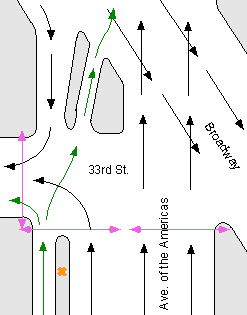 I was
standing on the raised barrier between the bike lane and the other lanes -- at the
location of the orange " X" in the
map -- as I took the photos below. The end of the barrier is visible at the bottom of the
photo, just to the left of the man who is walking from right to left.
I was
standing on the raised barrier between the bike lane and the other lanes -- at the
location of the orange " X" in the
map -- as I took the photos below. The end of the barrier is visible at the bottom of the
photo, just to the left of the man who is walking from right to left.
The extension of the bike lane is just behind the walking man in the photo. A man pedaling a delivery tricycle is in the bike lane. Notice that there are special signals for the bike lane crossings of 33rd Street and again, at Broadway. The bike lane signals for the 33rd Street crossing are green in the photo.
At the top left on the map and at the left side of the photo, there is a special contraflow lane next to the bike lane to allow motor traffic from Broadway to turn right onto 33rd Street.
Looking north, toward the intersection

| The next photo begins a time sequence of photos. We'll first turn around and look to the south down the Avenue of the Americas. In the photo, the traffic light at 32nd Street is red, and pedestrians are crossing the avenue. There is a young man walking in the bike lane and eating a croissant. |
Sequence photo 1: looking south

In the next photo, looking north, the gray car near the left side is turning from the
contraflow lane onto 33rd Street. A man in a black trench coat and a woman with a large
purple 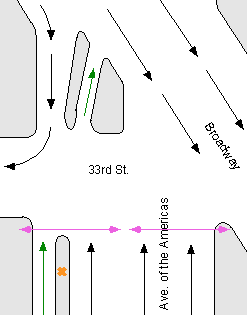 handbag are lawfully crossing the Avenue of the
Americas in the crosswalk. Our friend with the croissant is also about to cross the
Avenue, and now we understand why he had chosen to jaywalk in the bike lane: it was a
short cut for him. handbag are lawfully crossing the Avenue of the
Americas in the crosswalk. Our friend with the croissant is also about to cross the
Avenue, and now we understand why he had chosen to jaywalk in the bike lane: it was a
short cut for him. In the drawing at the right, only the movements for which arrows are shown are lawful at the time the photo below was taken. Behind the woman with the purple handbag is a bicyclist identifiable as a courier by the bag he carries. He chose not to ride in the bike lane or to obey the traffic signals. Also, there is a woman jaywalking at the right side of the photo. |
Sequence photo 2: looking north
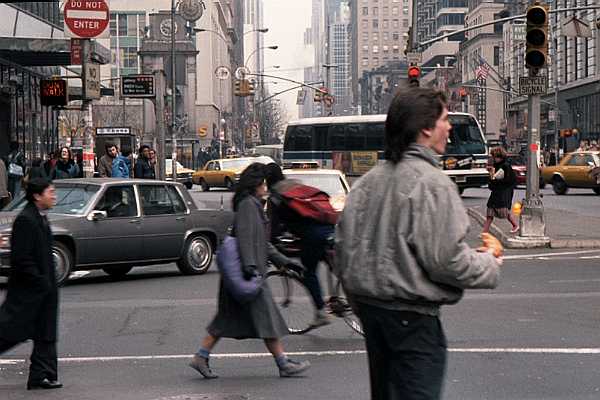
| In the next photo, we are again looking south, down the Avenue of the Americas. The
traffic signals have changed, and the traffic has started to move on the Avenue. Three
cyclists are visible in the photo. On the left in the photo is a bicycle courier who has chosen to use the normal travel lane. For him, time is money. He rides every day and is physically fit. He is riding an efficient multispeed bicycle. He has two logical reasons to avoid the bike lane:
The barrier-separated bike lane extends only as far south as 32nd Street. Behind the man pedaling a delivery tricycle and the other on a single-speed "cruiser" bicycle, you can see a "door zone" bike lane typical of most bike lanes on avenues in Manhattan. At the time I took the photo below, the lawful traffic flow was as in the map at the right. |
Sequence photo 3: looking south
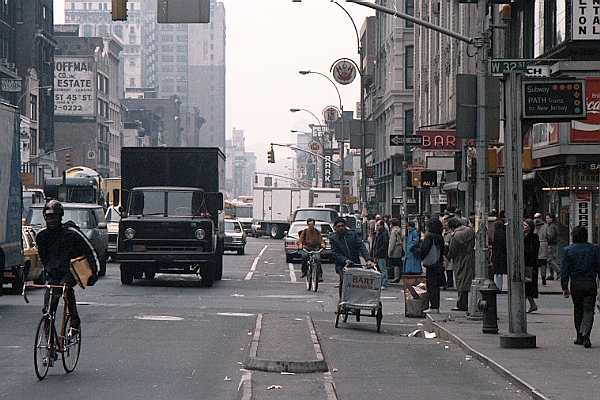
If you look carefully, you can find the same concrete mixer truck at the left side of
the photo above, and the right side of the photo below, which 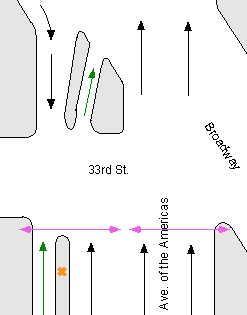 I took about 30 seconds later. In the photo below, the
courier is no longer visible. He may have turned left onto 33rd street -- with the traffic
light, unlike the other courier -- or he may be concealed by other traffic on the Avenue. I took about 30 seconds later. In the photo below, the
courier is no longer visible. He may have turned left onto 33rd street -- with the traffic
light, unlike the other courier -- or he may be concealed by other traffic on the Avenue.The traffic lights at 33rd Street have just turned red, and pedestrians are beginning to cross the Avenue. Both sets of special bicycle signals are red. The man on the cruiser bicycle (right, under traffic light) has passed the man on the delivery tricycle, run the red light at 33rd Street, and ridden across the entrance to the bike lane north of 33rd Street. The man on the delivery tricycle is waiting for the signal at 33rd Street (behind pedestrians, lower left). |
Sequence photo 4: looking north
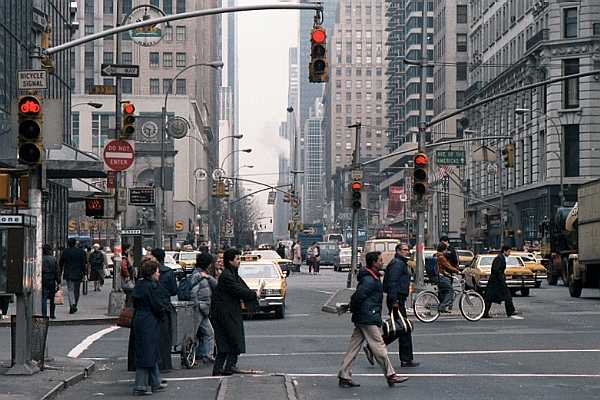
I have drawn arrows pointing at the cyclists in the next photo, so you can find them
more easily. The signal for the contraflow lane has turned green, and vehicles in that
lane are turning right into 33rd Street. The traffic signal for the bike lane crossing of
33rd Street has also turned 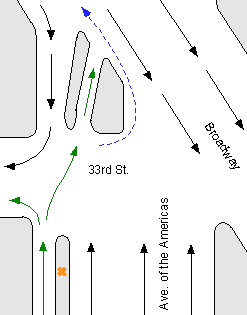 green, and the man on the delivery
tricycle (light green arrow) has crossed 33rd Street into the bike lane channel that leads
to Broadway. green, and the man on the delivery
tricycle (light green arrow) has crossed 33rd Street into the bike lane channel that leads
to Broadway. Lawful traffic movements are shown by solid arrows in the map at the right. The route taken by the man on the cruiser bicycle is indicated by the dashed blue arrow. His intention may have been to get past the earlier red in the bike lane by riding around the traffic island. Now he is stranded in the middle of Broadway between two flows of oncoming traffic. The dashed blue arrow in the photo points at him. The photo is the same one used at the start of this article, because it most clearly shows the elements of the intersection. |
Sequence photo 5: looking north

| In the next photo, the delivery tricyclist has proceeded from the bike lane and is
headed north up the Avenue of the Americas (light green arrow in photo). Another bicyclist
has proceeded from the bike lane across 33rd Street against a red light. This photo
also shows the one unresolved Through traffic on the Avenue may now proceed, while through traffic in the bike lane is required to stop at 33rd Street. As traffic has just started to move through the system of synchronized signals, this is the most likely time for a bicyclist to arrive. A bicyclist who arrives at 33rd Street in the bike lane at this time and obeys the signals will have to wait through an entire light cycle before crossing Broadway. |
Photo 6: looking north
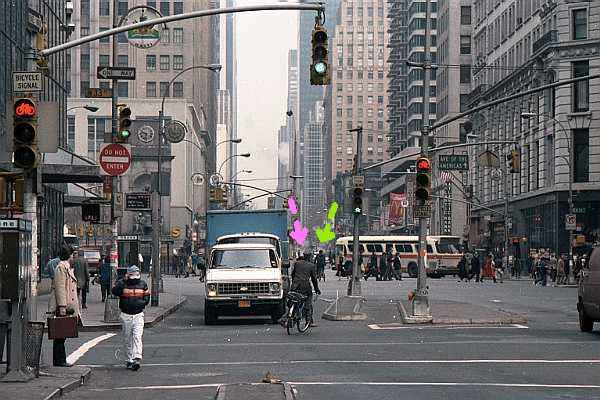
In the next and final photograph, the last bicyclist is still visible as he continues
on up the Avenue. In the foreground, 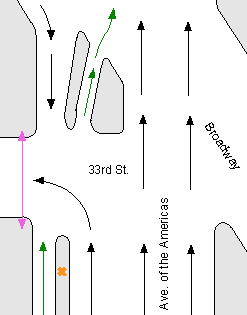 the red
truck has turned across the bike lane and into 33rd Street, across the crosswalk whose
signal is still in the "walk" phase. The conflict between turning traffic and
pedestrians is usual in New York, but it is worsened by the presence of the bike lane.
Because the bike lane shields pedestrians from motor traffic on the Avenue, they step out
across it so they will have a shorter walk across the Avenue once they get the
"walk" signal. These pedestrians can obscure motorists' view of other
pedestrians who may be in the north-south crosswalk. the red
truck has turned across the bike lane and into 33rd Street, across the crosswalk whose
signal is still in the "walk" phase. The conflict between turning traffic and
pedestrians is usual in New York, but it is worsened by the presence of the bike lane.
Because the bike lane shields pedestrians from motor traffic on the Avenue, they step out
across it so they will have a shorter walk across the Avenue once they get the
"walk" signal. These pedestrians can obscure motorists' view of other
pedestrians who may be in the north-south crosswalk. In this photo as in an earlier one, a pedestrian is walking in the bike lane. |
Photo 7: looking north
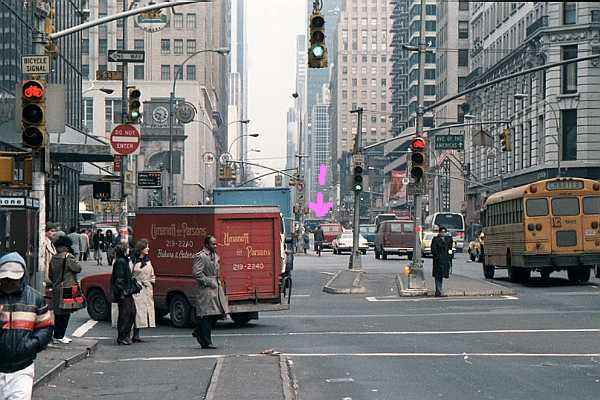
| What can we learn from this sequence of photographs? Although the five bicyclists seen in the photo are too small a number to allow any statistically valid conclusions, there is clearly a significant amount of bicycle traffic here, despite congested traffic conditions. The cyclists split into two categories, well known in the bicycling community:
Again, the five bicyclists in the photos don't allow statistical conclusions, but it is notable that there are examples of traffic signal violations, and of riding according to the traffic rules, in both groups. I regard the traffic signal for the Broadway crossing as a success, though it might be modified as I suggest below. As I have already indicated, this signal serves a useful and important purpose. The problem is with the bike lane and the special traffic signal at 33rd Street. These result in additional delay to all categories of road users, but especially to the cyclists who use the bike lane. And this situation is at the root of a problem. As one bicycling advocate has stated:
The design of this intersection is strictly "by the book", Dutch style: the bike lane has been placed outside the left turn lane, like a sidewalk, and then turning and crossing conflicts between bicyclists and other traffic have been eliminated by providing a special signal phase for the bike lane, pedestrian-style. But two of the three users of the bike lane chose to ignore the signal, and one of these two improvised his own, unusual route through the intersection. One of the two bicyclists who did not ride in the bike lane also chose to ignore the signals. So it's a valid question about both groups of cyclists: what is going to promote predictable and lawful behavior? Can we force American bicyclists to operate by pedestrian rules? Well, we can establish the pedestrian rules, as at this intersection. But, lacking stringent enforcement, bicyclists will ignore them. There is no widespread call for such enforcement. Nor is there one for enforcement against bicyclists who violate vehicular rules. It's a tough problem, but in my opinion Forester is right. American bicyclists are not going to comply better with the law by creating conditions that are more restrictive for them. Attempting to encourage bicycling by building facilities which hold out the promise of safety in return for long waits and slow travel is a recipe for chaotic behavior, and so for decreased rather than increased safety. How might the intersection have been designed to give bicyclists their advanced
warning, but without causing extra delay? My suggestion is in the With my design, bicyclists could still have a special signal before Broadway that turns yellow and then red earlier than for the motor traffic. The yellow might reflect the lowest speed of bicyclists, typically 8 miles per hour, and the red, the highest speed, typically 25 miles per hour. Also, the timing of the signal for motor traffic might reflect that actual speed of traffic. It is even conceivable that the motorists' red might have to be earlier than the bicyclists', if motor traffic is congested. Traffic signals which sense the speed of traffic are entirely practical using traffic sensing and computer control. My proposed intersection design would eliminate significant delays to bicyclists, and would accommodate faster and slower bicyclists equally well. It would also provide a place of refuge for pedestrians near the middle of the intersection and which does not create the visibility problems of the present design. My design would not place bicyclists in the close proximity to head-on traffic which you can see in sequence photo 6. How restrictive is the New York law? Very much so. Any bicyclist who does not ride in the barrier bike lane is violating New York State law. (Bike lanes are now defined as "bicycle or in-line skate lane" -- a change in the statutes that has occurred since I took the photos). Dumping in-line skaters into the same category as bicyclists worsens the problem considerably for bicyclists, because in-line skaters are slow, and they are wide with their flailing arms and legs. The lane merely has to be "usable" for its use to be mandatory. The word "usable" is open to interpretation, but it is rather more stringent in the barrier-separated lane where the bicyclist does not have the option to merge into the next lane to overtake an in-line skater or slower cyclist, and also must wait through the additional traffic signal cycle. On the New York State legislative Web site, you may find the applicable law (or search on "1234" here to see this in its frame), and the excerpt of interest reads as follows. If and when this law is enforced, it will seriously impede bicyclists who could go faster outside the bike lanes. Note also that the law assumes that bike lanes are on the right side of the street rather than on the left, like most on New York City's one-way avenues.
|
Contents © 2001, John S. Allen |